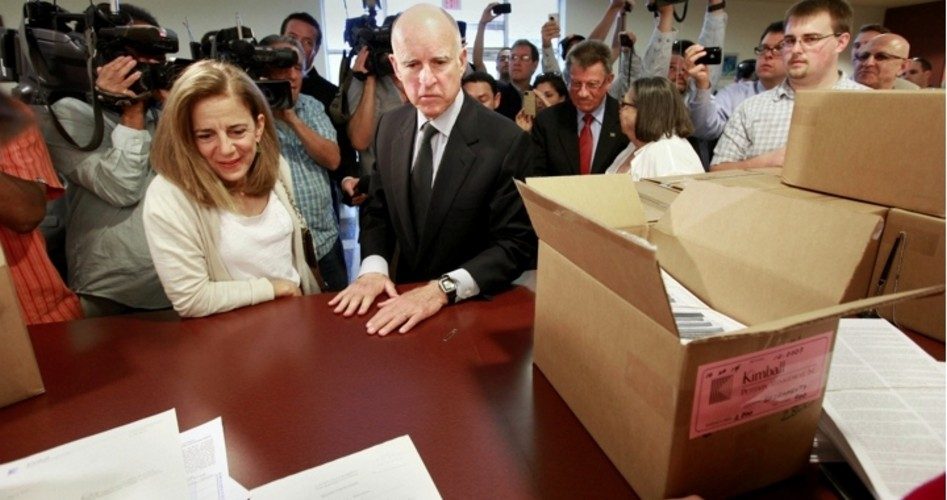
California Governor Jerry Brown is calling for higher taxes as lethargic economic growth has left his state, the world’s ninth-largest economy, in fiscal turmoil. In January, the 74-year-old Democrat set out to trim California’s $9.2 billion deficit, but has instead found the fiscal gap widen to nearly $16 billion. Tax revenue has dropped $3.5 billion below what Brown estimated at the beginning of the year, while spending has spiked $2 billion above projections and court rulings have hindered the state from enacting spending cuts decided on earlier this year.
Mr. Brown on Monday unveiled a budget initiative that entails $8.3 billion in spending cuts, including reductions in state employee compensation and spending on social programs and the state’s prison system. “I don’t like making additional cuts, and I recognize the impact they have on Californians,” he asserted when releasing his budget proposal. “They are difficult — but necessary — in order to get us back on firm fiscal footing until California fully recovers from the global economic recession.”
Brown also mentioned that California would have to implement another $6 billion in spending cuts on public schools and higher education if voters reject his call to increase sales and income taxes. At the same time, however, the Governor suggested a 16-percent boost in public school funding, but only if voters approve a quarter-cent increase in the sales tax, as well as an income tax surcharge on the state’s highest earners.
More specifically, the Governor’s plan to curb the state’s rapidly swelling deficit involves deepening cuts to healthcare, locking up state offices one day a week, and a catalog of other short-term fixes — all in the faith that a vote in November will enact higher taxes. The revised proposal would boost reductions in Medi-Cal, California’s healthcare program for the poor, to $1.2 billion, while saving $400 million by implementing a four-day work week for government offices.
In January, Brown threatened severe education cuts if voters refuse to accept his $6.9 billion in new taxes, which the The New American reported on earlier this year:
In hawking his 2012 budget proposal, Brown warned voters that without the temporary new taxes, which would be scheduled to expire in 2016, the state would have to drastically reduce its education budget — which, the Governor noted, would likely shorten the school year by three weeks. If voters accept his proposal, Brown suggested, the state could undergo serious debt reduction while reversing recession-era cuts to K-12 schools, which have already shortened the school year and inflated student-teacher ratios.
If the tax increases are not carried out, state officials warned at the time, reductions in education spending would automatically go into effect. However, “[w]ith the tax program, we will eliminate the budget deficit finally, after years of kicking the can down the road,” Brown contended.
Brown’s call for deep spending cuts will certainly clash with his Democratic allies in the California legislature, but he is insistent that financial responsibility (even if it is temporary) is necessary to reroute the state onto a sound fiscal path. “The fact is, California has been living beyond its means,” he said during a news conference in Sacramento. “The United States of America and its federal government has been living beyond its means. Well, there has to be a balance and a day of reckoning. This is a day of reckoning, and we have to take the medicine.”
“What government does is good,” Brown continued. “And a lot of Democratic legislators see the good and they are really troubled by cutting back on something basic that is good. But the fact is, we are in a democratic society. We have so much money from the people. And we have so much spending. We can be out of alignment for a while. But now, given the decade of fiscal disconnect, I’ve committed to right the ship of state and getting it into balance.”
Interestingly enough, the Governor blames the state’s paling economy for the rising deficit, but then proposes increasing taxes on the drivers of California’s economy. The Pacific Research Institute refers to the state as “Taxifornia,” as it harbors the highest personal income taxes in the U.S., and has higher sales taxes than all but four other states. Due to such a hostile business environment, businesses and wealthy investors are migrating across state lines to find more favorable tax rates in pro-business states. Breitbart.com recently reported on the trend:
Spectrum Locations Consultants recorded 254 California companies moved some or all of their work and jobs out of state in 2011, 26% more than in 2010 and five times as many as in 2009. According SLC President, Joe Vranich: the “top ten reasons companies are leaving California: 1) Poor rankings in surveys 2) More adversarial toward business 3) Uncontrollable public spending 4) Unfriendly business climate 5) Provable savings elsewhere 6) Most expensive business locations 7) Unfriendly legal environment for business 8) Worst regulatory burden 9) Severe tax treatment 10) Unprecedented energy costs.
California has the worst business climate in the nation, Vranich averred, and Los Angeles is the worst city to launch a new business. In fact, packing up L.A. operations and moving to a surrounding county could save businesses up to 20 percent in costs. Meanwhile, leaving California for Texas can save a whopping 40 percent of costs. The state’s high taxes and regulations are likely the reason why California exhausted 120,000 jobs last year and Texas accrued 130,000 jobs.
In effect, higher taxes and regulations are impediments to economic growth, so if a stagnant economy is the number-one catalyst to California’s fiscal misfortunes, why is Gov. Brown so insistent on imposing higher taxes on the state’s economic drivers?
Photo: Gov. Jerry Brown and his wife, Anne Gust Brown turn in boxes of petitions for his tax-hike initiative at the Sacramento County Registrar of Voters, May 10, 2012: AP Images



